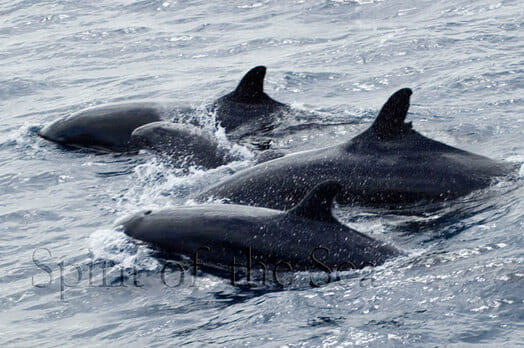False killer whale
Sighting
False killer whale in Gran Canaria (Pseudorca crassidens)
The false killer whale in Gran Canaria, also known as Pseudorca crassidens, is one of the most impressive species you can find in the waters surrounding the island. Although its name does not directly relate to its name, it belongs to the family of oceanic dolphins (Delphinidae), being one of its largest members.
These specimens have a long, slender body that is uniformly dark grey to black in colour, often with a slightly lighter patch between the pectoral fins on the underside. They have a small, rounded head without a distinctive beak and a sickle-shaped dorsal fin. However, their most distinctive feature is the ‘elbow’ or prominent protuberance on the front edge of their fins.
This fascinating marine mammal inhabits tropical and temperate waters around the world, mainly in open and deep ocean environments. Although they are widely distributed, they are not considered abundant in any specific area.
Physical characteristics of the false killer whale
One of the most distinctive characteristics of false killer whales in Gran Canaria is that males can grow up to 6 metres long and weigh up to 2.2 tonnes, while females are slightly smaller, measuring up to 5.4 metres and weighing around 1.1 tonnes.
They feed mainly on large fish and cephalopods. They have also been observed preying on smaller marine mammals, including dolphins, making them opportunistic predators.
Finally, these creatures have a gestation period of between 14 and 16 months, and females usually give birth to one calf every 6 or 7 years, which is suckled for approximately two years.
Intelligence and social behaviour
False killer whales in Gran Canaria are social, highly intelligent and very active animals. They form groups ranging from 10 to 50 individuals, although supergroups of hundreds, even thousands, have been recorded. This social structure allows them to hunt cooperatively, share food and maintain close bonds between group members.
Among their most striking behaviours are:
- Fast swimming and jumping out of the water, often approaching boats to ride the bow waves.
- Complex vocal communication, using whistles and clicks.
- Participation in mass strandings, a phenomenon still poorly understood by scientists, where large groups arrive at the coast simultaneously.
If you want to discover and learn more about the behaviour of this species of dolphin, don’t miss the opportunity to embark on a unique adventure with our expert team.




